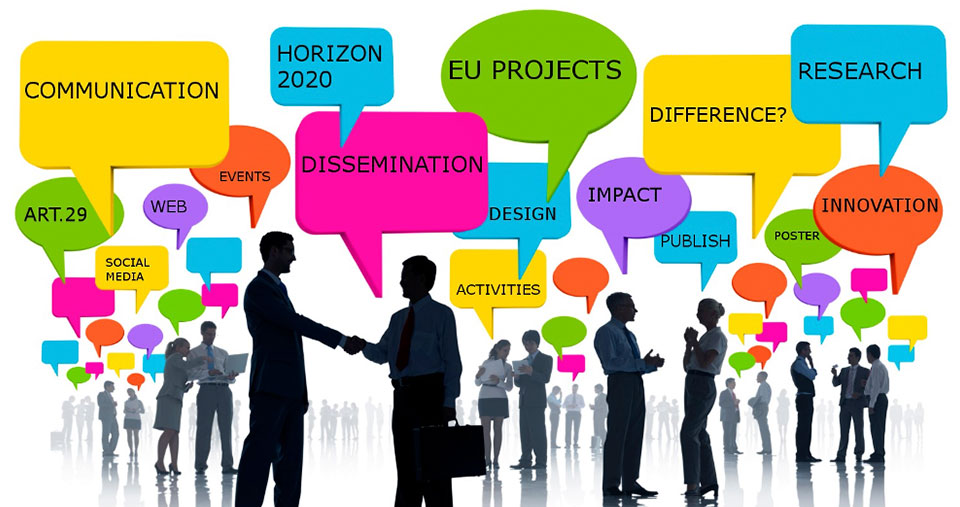
In European projects, the term “dissemination” indicates the set of actions and strategies aimed at disseminating information on the results of the project to maximize its impact on individuals, entities, and communities. This is essential as it facilitates the transfer of results and their use by a wider audience.
Therefore, this project activity deserves particular attention both in the drafting phase of the project proposal and during its implementation.
Dissemination and communication
“Dissemination” and “communication” are two concepts often used interchangeably, but we need to clarify this point.
When we talk about dissemination, we refer to the transfer of results to favour their exploitation (also of an economic type) in a perspective of practical use. In this case, the target audience will be subjects specialized in a specific sector, such as the scientific community or legislators.
On the other hand, communication includes information and promotion activities to increase the visibility of the project and therefore is aimed at a more generic target (public opinion, the media). Consequently, it may be more effective to plan an overall strategic framework that covers both activities to make the most of available resources.
The dissemination strategy
The dissemination strategy of European projects must define the structure and content of the messages to be transmitted, which segments of the population it is most useful to send them, and which are the most suitable channels to convey them. The critical elements of our communication/dissemination plan will be:
- WHAT: define what to communicate, messages and products
- TO WHOM: identify the target group for dissemination
- WHY: define the aims of dissemination
- HOW: plan the dissemination method
- WHEN: to establish the most opportune moments to achieve the dissemination objectives.
In European projects, a good dissemination plan should include measurable and realistic objectives, meet a timetable and provide resource planning for the activities to be carried out. Involving the target groups in the activities will also help maximize the use of the project results.
- What to disseminate?
Project outcomes may include concrete (tangible) results, knowledge, skills, and experience that both the project organizers and the participants have acquired (abstract results). Some examples:
- Products
- Methods
- Experiences
- Best practices
- Recommendations
- Guidelines
- Who are the stakeholders of the dissemination?
Institutional interlocutors: they require constant updating concerning the implementation phases of the project. In particular, the European Commission needs communications that can account for the positive investment made in financing the project.
Stakeholders: they are qualified stakeholders and can evaluate the project’s effects in technical and economic terms.
Citizens: while not having a direct interest in the project’s results, they can still benefit from it in terms of quality of life, opportunities for the territory, etc.
Media: they are strategically important as they can amplify their communications, giving strong resonance to the project actions.
- Why disseminate the project?
- To disseminate information both on the project in general and on specific activities and products, highlighting their added value and innovativeness;
- To raise awareness of the importance of the project for the areas concerned;
- To strengthen and broaden the involvement and participation of target groups;
- To facilitate and strengthen the relationships between the project partners to achieve the expected results;
- To publicize the funding of the European Commission and its commitment to the development of territories and citizens;
- To influence decision-makers and facilitate their decisions by formulating recommendations;
- To raise the awareness of future funding authorities by ensuring the continuity and sustainability of the project.
- How to disseminate the results?
There are different methods of disseminating European projects. To maximize its impact and reach new audiences, it is advisable to make the most of social channels and adopt a balanced mix of online and offline communication tools: website, workshops, seminars, conferences, press releases, audiovisual and multimedia products, public events, contacts and existing networks.
- When to disseminate the results?
The dissemination activity is an integral part of the project for its entire duration. Here are some examples of dissemination activities based on the different phases of the project.
BEFORE the project:
- develop the dissemination and enhancement plan;
- define the impact and expected products;
- determine how the dissemination and exploitation activities will be disseminated and their recipients.
- assign adequate budget and resources to dissemination activities.
DURING the project:
- contact the appropriate means of communication at the local or regional level;
- conduct regular activities such as information sessions, training, demonstrations, peer reviews;
- assess the impact on target groups;
- involve other stakeholders given the transfer of results to end-users.
AFTER the project:
- develop ideas for future cooperation;
- evaluate the results and impact;
- contact the relevant media;
- contact policymakers if relevant.
In conclusion, dissemination activities are a valuable tool for measuring results and generating recommendations for future improvements. The dissemination managers of the IE3 project constantly evaluate the dissemination activities’ success to measure progress towards the set objectives and use them accordingly as performance indicators. In this regard, the hands can be quantitative, about numbers and percentages, and qualitative, concerning the quality of participation and experience.
To keep yourself informed about the latest news from the IE3 project, subscribe to our newsletter and follow our social media channels!
Written by Francesco Paolo Contò – Infotech team, Italy

